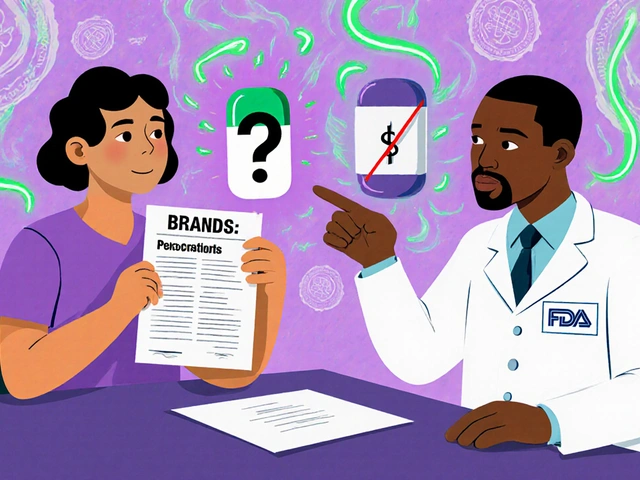
Quitting smoking isn’t just about willpower. It’s about finding the right tool for your body, your habits, and your life. If you’ve tried quitting before and failed, you’re not alone. Nearly 70% of smokers want to quit, but only 4-7% succeed without help. That’s where medications like varenicline come in. But is it the best choice? How does it stack up against nicotine patches, gum, or even antidepressants? Let’s cut through the noise and show you exactly how varenicline compares to other quit-smoking aids - and which one might actually work for you.
What is varenicline, really?
Varenicline, sold under the brand name Champix in the UK and Chantix in the US, is a prescription medication designed to help people stop smoking. It doesn’t just replace nicotine like patches or gum. Instead, it works on your brain’s nicotine receptors. When you take varenicline, it partially activates those receptors, which reduces cravings and withdrawal symptoms. At the same time, it blocks nicotine from binding to them - so if you smoke while taking it, you won’t get the usual pleasurable rush.
It’s not a nicotine product. You don’t inhale it. You don’t chew it. You swallow a pill, usually once or twice a day, starting one to two weeks before your quit date. Most people take it for 12 weeks, though some extend it to 24 weeks if they’re doing well. Clinical trials show that about 22% of people who take varenicline for 12 weeks quit smoking for good - compared to about 10% who take a placebo.
How varenicline stacks up against nicotine replacement therapy (NRT)
Nicotine replacement therapy - patches, gum, lozenges, inhalers, sprays - is the most common approach. It’s available over the counter, cheap, and safe for most people. But here’s the catch: it only replaces nicotine. It doesn’t touch the brain’s reward system the way smoking does.
Studies from the Cochrane Collaboration show that varenicline is about twice as effective as nicotine patches. In a 2023 review of 12 large trials, 21-24% of people quit using varenicline, while only 10-13% quit using patches alone. Gum and lozenges performed similarly to patches.
Why the difference? Because varenicline doesn’t just ease withdrawal - it changes how your brain responds to smoking. If you’ve tried patches and still felt that strong urge to smoke, especially in certain situations like after coffee or with friends, varenicline might be the next step.
How does varenicline compare to bupropion?
Bupropion (Zyban) is an antidepressant repurposed for smoking cessation. It works differently from varenicline - it affects dopamine and norepinephrine in the brain, which helps reduce cravings and withdrawal. It’s also prescription-only and taken as a pill.
Head-to-head trials show varenicline outperforms bupropion. In a 2022 analysis of over 10,000 smokers, varenicline users were 50% more likely to quit after six months than those using bupropion. Both are better than placebo, but varenicline has a clearer edge.
That said, bupropion might be better for people who can’t take varenicline. If you have a history of seizures, severe depression, or certain heart conditions, your doctor might lean toward bupropion. But if you’re healthy and want the highest chance of success, varenicline is the stronger option.
What about newer options like cytisine?
Cytisine is a plant-based compound that works almost exactly like varenicline - it binds to nicotine receptors and reduces cravings. It’s been used in Eastern Europe for decades and is now gaining traction in the UK and US.
Here’s the surprise: a 2024 UK trial compared cytisine to varenicline in over 1,000 smokers. The quit rates were nearly identical - 19% for cytisine, 20% for varenicline. But cytisine costs about £15 for a full course. Varenicline costs over £100.
That makes cytisine a compelling alternative if cost is a barrier. It’s not yet widely available on the NHS, but you can buy it online from licensed UK pharmacies. If you’re looking for a budget-friendly option with similar effectiveness, cytisine deserves a serious look.

Side effects: what you need to know
No quit-smoking aid is side-effect-free. Varenicline’s most common side effects are nausea (affects about 30% of users), trouble sleeping, and vivid dreams. Most of these fade after the first week. A small number of people report mood changes, including depression or agitation. The UK’s MHRA warns that people with a history of mental health conditions should be monitored closely.
Nicotine patches cause skin irritation and headaches. Gum can give you jaw pain or upset stomach if chewed wrong. Bupropion carries a small risk of seizures, especially if you’re already taking other medications. Cytisine causes nausea too - sometimes worse than varenicline.
Here’s the reality: side effects are often manageable. If nausea hits, take varenicline with food. If sleep gets disrupted, take your evening dose earlier. Most people tolerate it well enough to keep going - and that’s what matters.
Who should avoid varenicline?
You shouldn’t take varenicline if you:
- Have a history of seizures
- Are under 18
- Are pregnant or breastfeeding (unless advised by a doctor)
- Have severe kidney disease
- Have uncontrolled high blood pressure or heart disease
If you’ve had depression, anxiety, or suicidal thoughts in the past, talk to your GP before starting. They might suggest starting with NRT or cytisine instead. It’s not a one-size-fits-all solution - it’s a tool that works best for certain people.
Combining treatments: does it help?
Some people think using multiple aids at once - like patches plus varenicline - will double their chances. That’s not always true. The evidence on combining varenicline with NRT is mixed. One 2023 trial showed a slight boost in quit rates (28% vs. 22%), but it also increased side effects like nausea and dizziness.
For most people, sticking to one proven method is better than mixing and matching. If varenicline alone isn’t working after 4-6 weeks, talk to your doctor about switching to cytisine or adding behavioural support - not more pills.

Behavioural support: the secret weapon
No medication works as well without support. The NHS Stop Smoking Services offer free one-on-one coaching, group sessions, and text message reminders. Smokers who use varenicline plus behavioural support are twice as likely to quit as those who use the pill alone.
Even simple things help: identifying your triggers (coffee, stress, alcohol), planning alternatives (chewing gum, walking, deep breathing), and telling friends you’re quitting. These aren’t fluff - they’re science-backed strategies that change your environment and habits.
If you’re serious about quitting, combine varenicline with a free NHS service. You don’t need to pay for private coaching. The NHS has trained advisors ready to help.
Real-world results: what actually works?
Let’s say you’re 45, smoke 15 cigarettes a day, and have tried patches before. You get cravings after work and when you’re stressed. You’re not depressed, but you hate the withdrawal headaches.
Varenicline is your best bet. It reduces cravings at their source. You’ll likely feel better after the first week. You might feel a bit nauseous, but taking it with dinner helps. You’ll still have urges - but they’ll be weaker. Combine it with a weekly NHS call, and your chance of quitting for good jumps to over 30%.
Now imagine you’re 62, have type 2 diabetes, and can’t afford £100 for a prescription. Cytisine gives you the same brain effect for £15. It’s just as effective. It’s worth trying.
Or maybe you’re 30, anxious, and terrified of side effects. Start with nicotine gum and free counselling. It’s safer, gentler, and still works for many.
There’s no universal winner. The right choice depends on your health, your budget, your triggers, and your tolerance for side effects.
Final decision: how to pick your quit method
Ask yourself these questions:
- Have I tried NRT before and failed? → Try varenicline or cytisine.
- Do I have a mental health condition? → Talk to your GP - bupropion or NRT may be safer.
- Is cost a big issue? → Cytisine is just as effective and costs a fraction.
- Do I want the highest chance of success? → Varenicline + NHS support is your best combo.
- Am I scared of side effects? → Start with nicotine gum or patches.
There’s no shame in trying one method and switching if it doesn’t work. Quitting smoking is a process, not a single event. Most people need more than one attempt. What matters is that you keep trying - with the right tools.
Don’t wait for the perfect moment. The best time to quit was yesterday. The second-best time is today. Talk to your GP. Get a prescription. Sign up for NHS support. And remember - you’re not just quitting cigarettes. You’re giving your heart, lungs, and future self a real chance to heal.
Is varenicline better than nicotine patches?
Yes, varenicline is more effective. Studies show about 22% of people quit using varenicline, compared to 10-13% using nicotine patches. Varenicline works on brain receptors to reduce cravings and block nicotine’s effects, while patches only replace nicotine without changing how your brain responds to smoking.
Can I take varenicline with nicotine gum?
It’s possible, but not usually recommended. Combining varenicline with nicotine gum can slightly increase quit rates, but it also raises the risk of nausea, dizziness, and headaches. Most people do better sticking to one method unless advised otherwise by their doctor.
What are the most common side effects of varenicline?
The most common side effects are nausea (affects about 1 in 3 people), trouble sleeping, and vivid dreams. These usually improve after the first week. Less common but serious side effects include mood changes, depression, or agitation - especially in people with a history of mental health issues.
Is cytisine a good alternative to varenicline?
Yes. Cytisine works almost identically to varenicline by targeting nicotine receptors. A 2024 UK trial found nearly identical quit rates - 19% for cytisine vs. 20% for varenicline. The big difference? Cytisine costs about £15 for a full course, while varenicline costs over £100. It’s a cost-effective alternative if you’re budget-conscious.
Does varenicline work for heavy smokers?
Yes. Varenicline is effective for both light and heavy smokers. In fact, people who smoke more than 20 cigarettes a day often benefit the most because varenicline strongly reduces cravings and the rewarding effects of nicotine. Starting one to two weeks before your quit date helps your body adjust before you stop smoking completely.






Jim Allen
October 31, 2025 AT 16:19krishna raut
November 2, 2025 AT 05:15Prakash pawar
November 3, 2025 AT 18:00Emily Kidd
November 4, 2025 AT 03:55Nate Girard
November 4, 2025 AT 21:58Justin Cheah
November 6, 2025 AT 21:24caiden gilbert
November 8, 2025 AT 11:38Carolyn Kiger
November 10, 2025 AT 04:15Alex Hundert
November 10, 2025 AT 12:27MOLLY SURNO
November 10, 2025 AT 15:32